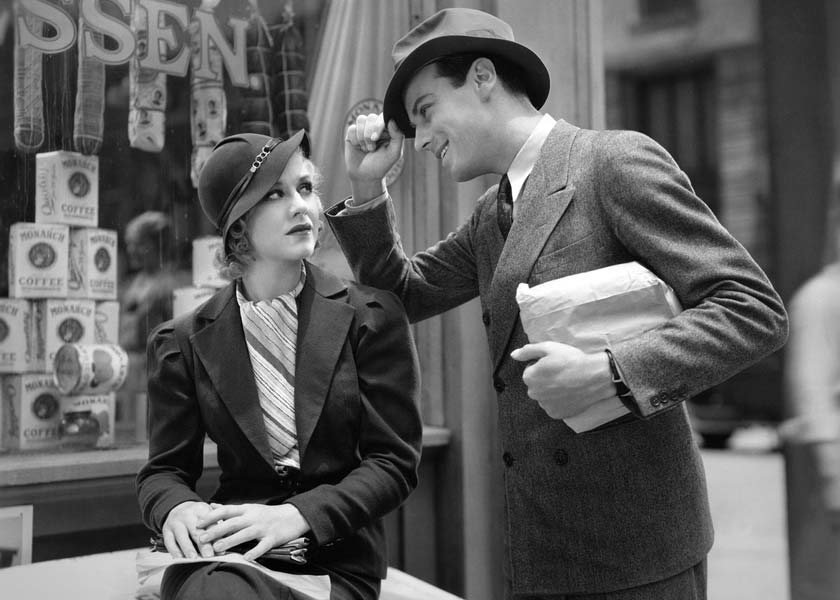Synopsis
Mary Carroll (Rogers) and Jack Bacon (Foster) are struggling to pay the rent on their apartments. Eckbaum (Sidney), their landlord, suggests that, without having to meet, they share the attic space on the fourth floor. Mary, who sells ice boxes, will occupy the space from 8pm to 8am, and Jack, a nightwatchman, will have it from 8am to 8pm. Reluctantly, each agrees.
Although they do not see one another, they quickly develop mutual enmity based upon petty grievances. Jack objects to Mary’s things left around the place and thinks of her as a fussy spinster. Mary objects to Jack’s arrangements and thinks he must be a crabby upstart from out of town. Soon, they are writing each other insulting, innuendo-filled, notes. They meet on the street outside the apartment. Mary, waiting for 8pm, is sitting at a delicatessen across from the apartment building. Not realizing who she is, Jack flirts with her. Another night, flirting again, they take a romantic walk in the park and agree to meet the next night for dinner.
In the attic, the enmity has advanced to sabotage. The night of the dinner, Jack has adjusted the makeshift shower so that the bucket through which the water flows falls on Mary’s head. In retaliation, Mary puts his only suit in the shower. When Jack turns on the water, his suit is soaked. In a rainstorm, Mary is waiting in the park for Jack who is trying to get his suit dried. They just miss each other at the park and at the delicatessen. The next day, Mary will not talk to him. That evening, they reconcile over a Chinese dinner. Back in the attic, Jack saws through the legs of the bed which collapses when Mary lies on it.
Jack and Mary go to a picnic. Jack hurts his ankle, and Mary takes him home in a taxi. She goes to his apartment with him, and they discover each other’s alternate identity. The built up enmity is too much to overcome immediately, and they separate. However, true love cannot be denied, and outside the apartment house, they kiss and make up. Eckbaum, watching them from his window, congratulates himself for having brought them together.
Discussion
Rafter Romance is a cute and fun romantic comedy revolving on a social problem of the Depression era. Unemployment and low wages prevented many people from affording good housing, even though housing was inexpensive. Two people forced to share an attic space, each on a part-time basis, is treated comically, but was a situation with which the contemporary audience would have been familiar. Director William A. Seiter maintains a lively pace during the short 73-minute running time. Ginger Rogers and Norman Foster effectively bring out the appealing personalities and the comic potential of their characters.
After several years in vaudeville and musical theater, Rogers made her first feature film in 1930 (Young Man of Manhattan, starring Foster and Claudette Colbert). For the next few years, she appeared in B-level fare, usually comedies, often as the female lead, such as in Carnival Boat (1932) and Professional Sweetheart (1933), sometimes as the wise-cracking friend of the female lead, such as in Hat Check Girl (1932), Broadway Bad (1933) and Finishing School (1934). She is even a murder victim in Upperworld (1934). Rogers advanced to stardom after she was paired with Fred Astaire in Flying Down to Rio (1933). In 1933, Rogers was still developing a screen persona. Compared to her screen presence later in her career, her voice is higher, her makeup softer, her personality less distinct, and her acting less polished. She looks pretty but lacks the refinement and glamour that came with experience and stardom.
Norman Foster, a lightweight actor, is amusing in his role and a pleasant partner for Rogers. He entered films in 1929 and by 1936 had appeared in over forty films, his roles almost equally divided between support and leads. By 1936, Foster’s acting career was stagnating, if not declining, into leads in very low-budget films and supporting roles in somewhat higher-budget fare. In 1936, he transitioned from acting to directing and writing for the B-unit of 20th Century-Fox. During the late 1930s, he wrote some of the screenplays and directed most of Peter Lorre's Mr. Moto films.

